Do you want to learn about the common moths of Pennsylvania?
Finding information about moths that are common in Pennsylvania wasn’t as easy as I thought. Some were incorrect, others did not have enough information, and some were just too hard to find.
That is why I created this post about the 10 Common Moths of Pennsylvania.
This ultimate guide will not only give you the types of moths of Pennsylvania or surrounding states but also important and interesting facts about them.
10 Common Moths of Pennsylvania
#1. Isabella Tiger Moth (Pyrrharctia isabella)
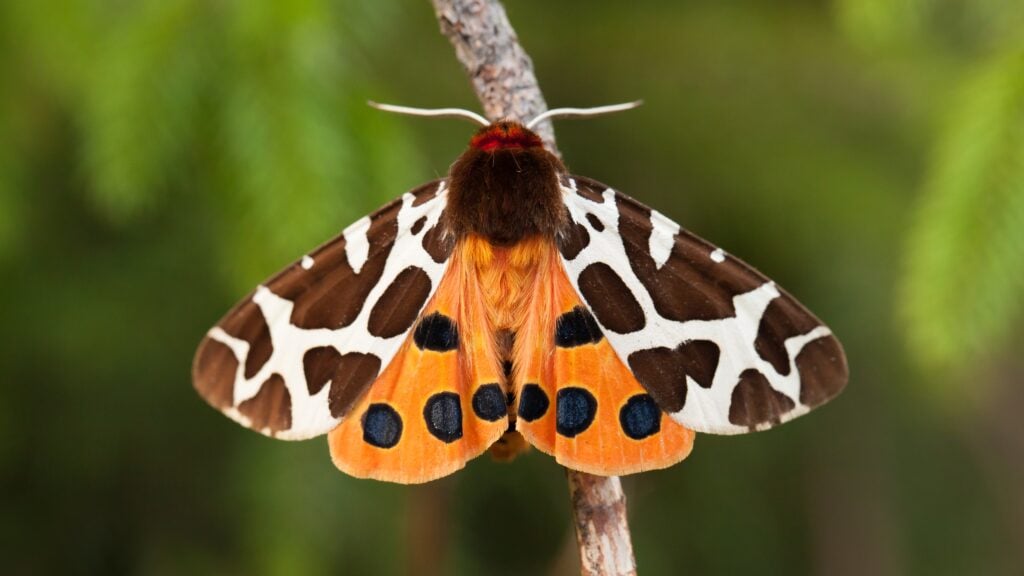
Identifying Characteristics and Facts
- Large Moth with a wingspan of up to 4 inches.
- Orange and black coloration.
- Found in different habitats including wooded areas, wetlands, and gardens.
- The Caterpillar is hairy with black with orange bands and eats milkweed plants.
- Adults usually fly in the late summer and early fall.
Isabella tiger moths are large moths that are easy to identify. You will see different habitats that include the grasslands and meadows, agricultural fields, and wetlands among other habitats.
The Isabella tiger moth is one of the common moths of Pennsylvania and plays a significant role in the ecosystem. They contribute a lot to nutrient cycling, both as a predator and also as prey to some birds. In addition to that, they also help a lot in promoting pollination.
These moths are not harmful to humans. They also feed on herbaceous plants and since they do not invade in large numbers, their presence would, therefore, cause insignificant damage to the crops.
#2. Clymene Moth (Stilpnotia clymene)
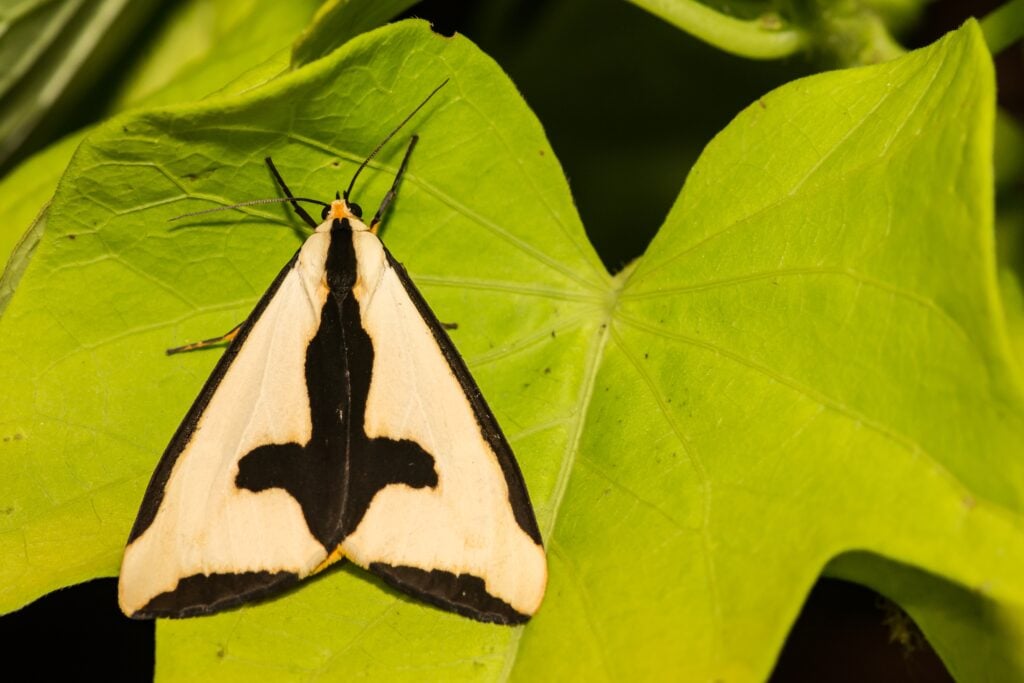
Identifying Characteristics and Facts
- Female moths are usually larger than males and lay eggs in clusters on the host plant’s leaves.
- Quite large and with a wingspan of 40 – 55 mm.
- White with a black border on their wings.
- Black cross pattern at the center of their backs.
- Small yellow head with black eyes.
- Often seen during hot summer days.
Clymene moths are beautiful and amazing creatures. You will enjoy seeing them in Pennsylvania gardens during the summer days.
One thing about these moths is that they are most active during the night. You, will, therefore, see them hovering near some light sources such as porch lights or outdoor lamps.
These moths live in a variety of habitats and environments that include woodlands, forests, and in suburban areas. They are also fairly distributed across the world. They usually undergo a complete metamorphosis of egg, larva, pupa, and adult.
It would also be important to understand something about their feeding and whether or not they are harmful. On that note, Clymene Moths are not harmful and also would not cause any noticeable damage to crops. In fact, adults are helpful in promoting pollination.
#3. Banded Tussock Moth (Habrosyne pyritoides)
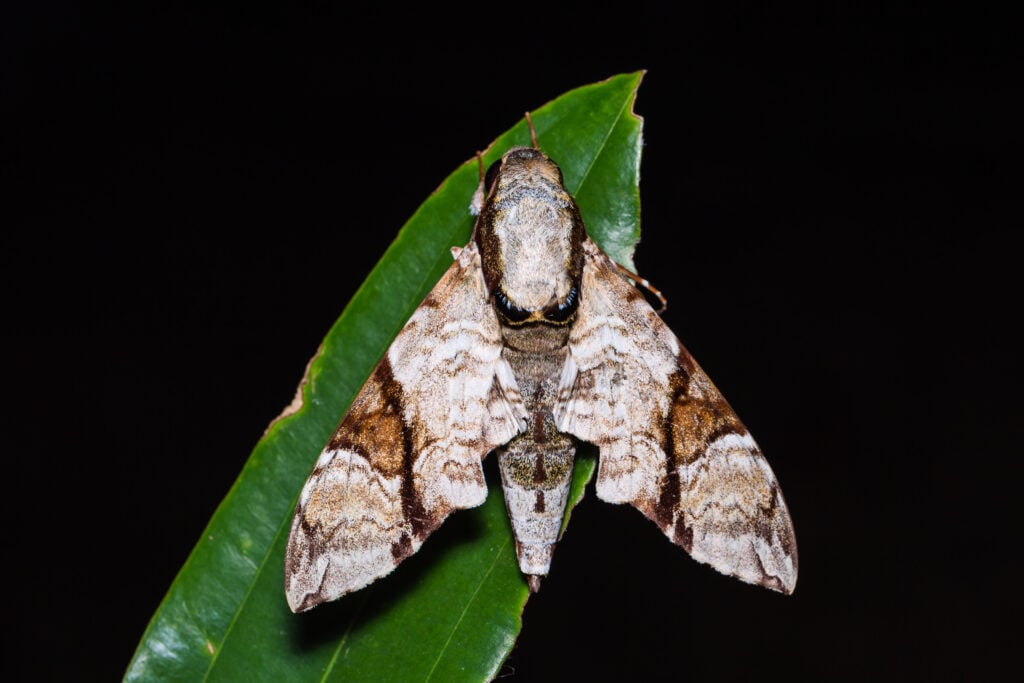
Identifying Characteristics and Facts
- Have a wingspan of about 2 inches.
- Orange hindwings and white bands on the abdomen.
- Contains irritating chemicals for defense.
- Feed on various plants like oak, willow, and maple and most common pests to most ornamental plants.
- Harmful as their hairs can be irritating to humans when in contact.
The Banded Tussock Moth, also known as Habrosyne pyritoides is one of the common moths of Pennsylvania. It is also a common insect in many parts of the world today.
When it comes to appearance, this moth features orange hindwings and a banded body covered in dense black and white hairs. These tufts of hair serve as a defense mechanism against predators since they contain irritating chemicals.
Throughout its life cycle, this moth undergoes metamorphosis starting from an egg and progressing through larval, pupal, and adult stages. It completes all stages of metamorphosis and hence is a unique insect study.
#4. Delicate Cycnia (Cycnia delicatula)
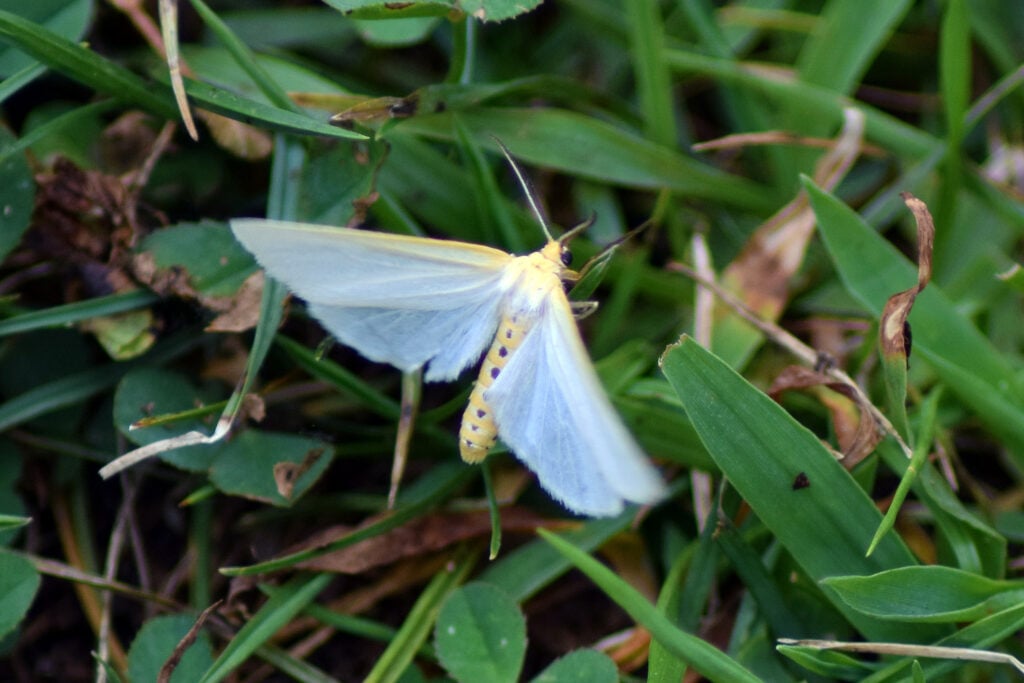
Identifying Characteristics and Facts
- Have a wingspan of 22 – 28 mm. with brown coloration with some black markings.
- Forewing marked with black and white eyespots.
- Usually active from late spring to early fall.
- They are always attracted to lights.
- Larva feeds primarily on the leaves of different plants.
The Delicate Cycnia is a moth species that belongs to the Erebidae family. It is one of the common moths of Pennsylvania and you will likely come across them mostly at night.
Regarding appearance, this moth species has a wingspan that typically ranges from 22 to 28 millimeters. The upper side of its forewings showcases a unique combination of white colors while the hindwings are usually light colored with dark spots.
It is also wise to note that the Delicate Cycnia is always active during the night. It searches for nectar from various flowers for sustenance since that is what they primarily eat. Additionally, it serves as a host for wasps that lay their eggs on the moths’ larvae.
Despite its appearance, this moth plays a role in the ecosystem by contributing to pollination and serving as a vital link in the food chain for other organisms.
#5. Virginia Ctenucha (Ctenucha virginica)
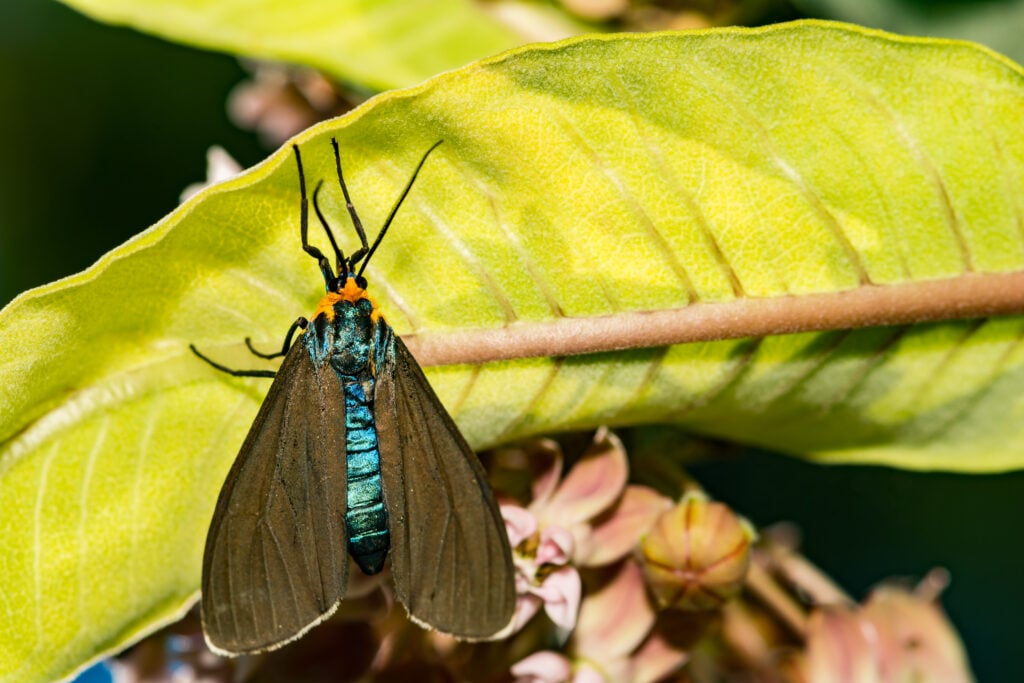
Identifying Characteristics and Facts
- Have a wingspan of 30 – 40 mm long.
- Most active during the day.
- Blue-black wings with some vibrant orange markings.
- Inhabit open woodlands, meadows, and gardens.
- Females usually lay eggs on grasses.
- Feeds on nectar.
This is a moth species that you will find in many countries of the world. It is also one of the common moths of Pennsylvania and is decently present in many other states.
What sets them apart is actually their appearance. They have blue-black wings adorned with vibrant orange markings alongside their fuzzy bodies featuring black and yellow bands. These moths also have a wingspan of 30 to 40 mm and tend to be active during the day.
In terms of habitation, they are commonly sighted in meadows, gardens, and open woodlands. They primarily feed on nectar from flowers such as goldenrods and milkweeds.
When it comes to reproduction, the female ones lay their eggs on grasses. And as they develop into caterpillars, they display a combination of black hues. Their larvae are often mistaken for butterfly caterpillars due to their appearance.
#6. Yellow-Collared Scape Moth (Euclemensia glyphica)
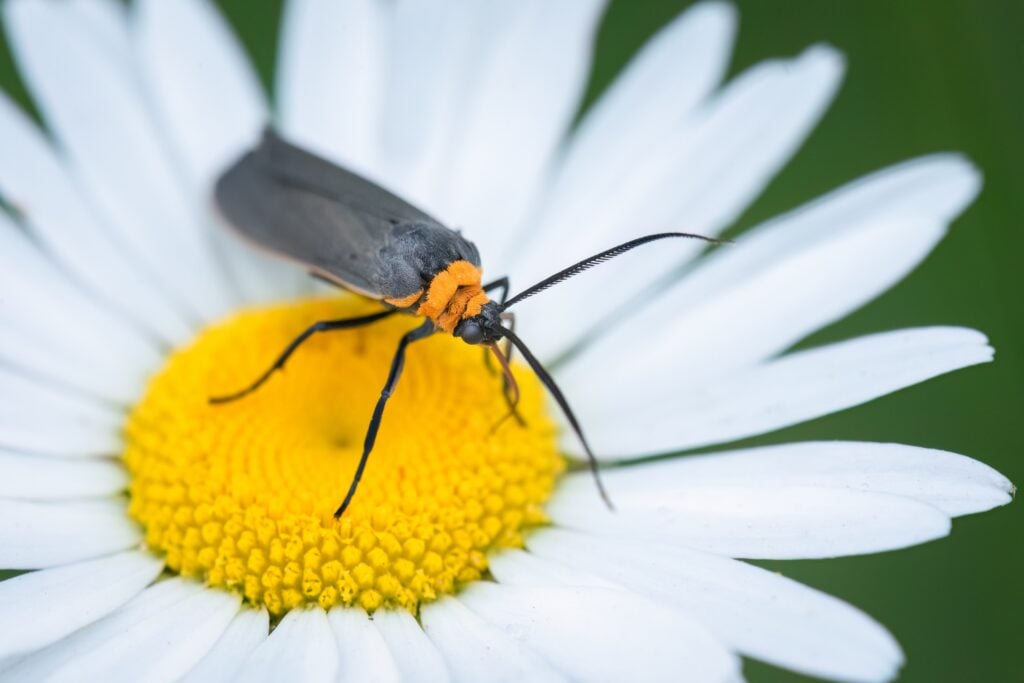
Identifying Characteristics and Facts
- They have a complete metamorphosis.
- Wingspan of between 20 – 25 mm.
- Display weak and fluttery flight.
- Mostly attracted to light.
- About 2.5 cm in body length.
- Feed on nectar, leaves, and the stems of plants.
The Yellow-collared moths are also present in Pennsylvania among many other parts of the United States. They are amazing creatures that play an important ecosystem role.
When it comes to distinctive appearance, these moths have a wingspan of around 20 to 25 mm. Their wings also display a combination of black and vivid yellow patterns, including a distinct yellow collar. This captivating appearance serves as a warning to predators, about its nature rendering it unappetizing and offering protection from being preyed upon.
In terms of habitats, these moths tend to inhabit woodland areas, meadows, and gardens where they nourish themselves by feeding on nectar from blooming plants.
As part of their life cycle, these moths go through metamorphosis starting as eggs and then transforming into caterpillars before undergoing pupation and eventually emerging as grown adults.
#7. Black Witch Moth (Ascalapha odorata)
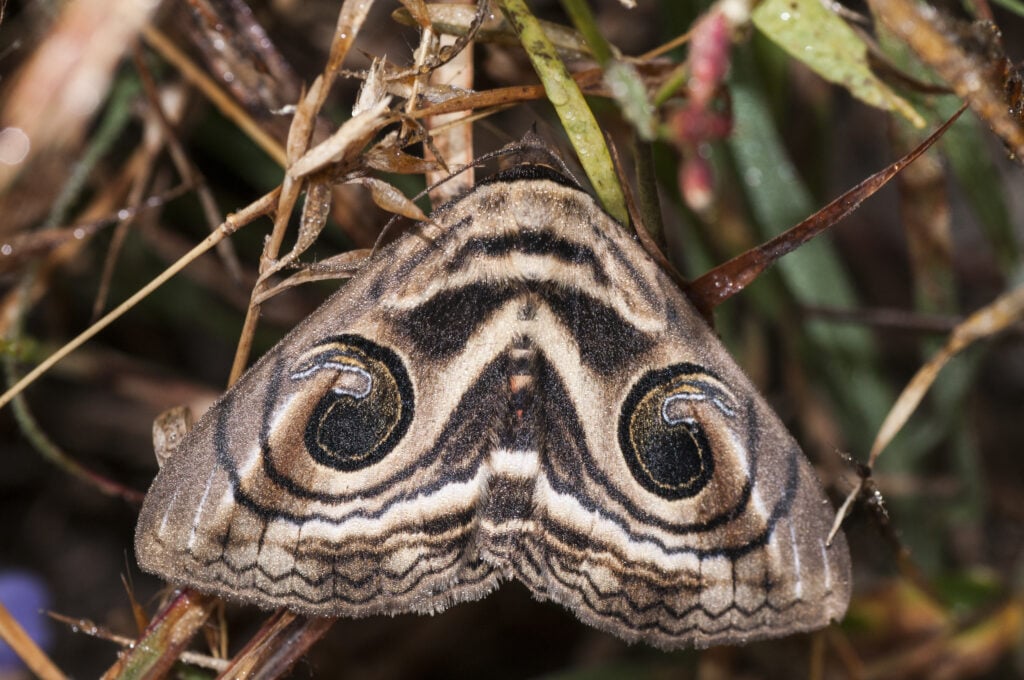
Identifying Characteristics and Facts
- Have a wingspan of about 7 inches.
- Wings are jet-black with iridescent markings.
- Mostly found in subtropical and tropical regions.
- Migratory and usually fly long distances.
- Have a lifespan of about 1 – 2 years.
- Feed on fruits and leaves.
- Nocturnal and most active at night.
The Black Witch Moth is an insect that captivates us with its appearance and mysterious charm. It is a moth species you can find in Pennsylvania and as well in many other parts of the world.
This beautiful creature, native, to the Americas boasts a wingspan of up to 7 inches making it one of the species of moths out there. Its jet-black wings are adorned with iridescent markings that create a captivating effect when illuminated by the moonlight.
Interestingly, this moth got its name from superstitions that associated it with omens and witchcraft. However, despite its reputation, the Black Witch Moth poses no harm to humans and actually plays a crucial role as a pollinator, and in maintaining ecological balance.
The moths’ intriguing migration patterns and nocturnal behavior only add to their presence captivating both entomologists and nature enthusiasts.
#8. Luna Moth (Actias luna)
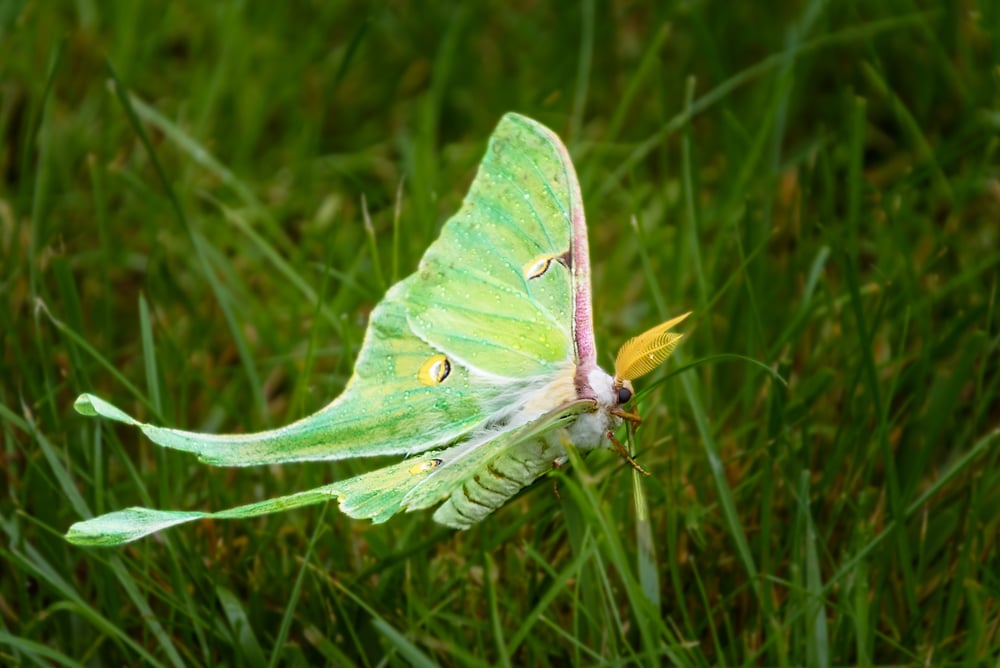
Identifying Characteristics and Facts
- Have a wingspan of about 4.5 inches.
- Pale green wings with transparent eyespots.
- Long and feathery antennae and a white body.
- Nocturnal and usually attracted to light.
- Females lay eggs on some specific tree leaves.
The Luna Moth, scientifically known as Actias luna is a wonderful creature that captures our attention with its beauty and elusive behavior.
This insect is famous for its lime wings, which can span up to 4.5 inches and are adorned with graceful and delicate tails. Therefore, identifying them or locating them from their habitats is not a hard task.
Despite their short adult lifespan of a week, these enchanting creatures dedicate their time to the mission of finding a mate and reproducing. During their flights, they rely on their sense of smell to locate potential partners.
#9. Polyphemus Moth (Antheraea polyphemus)
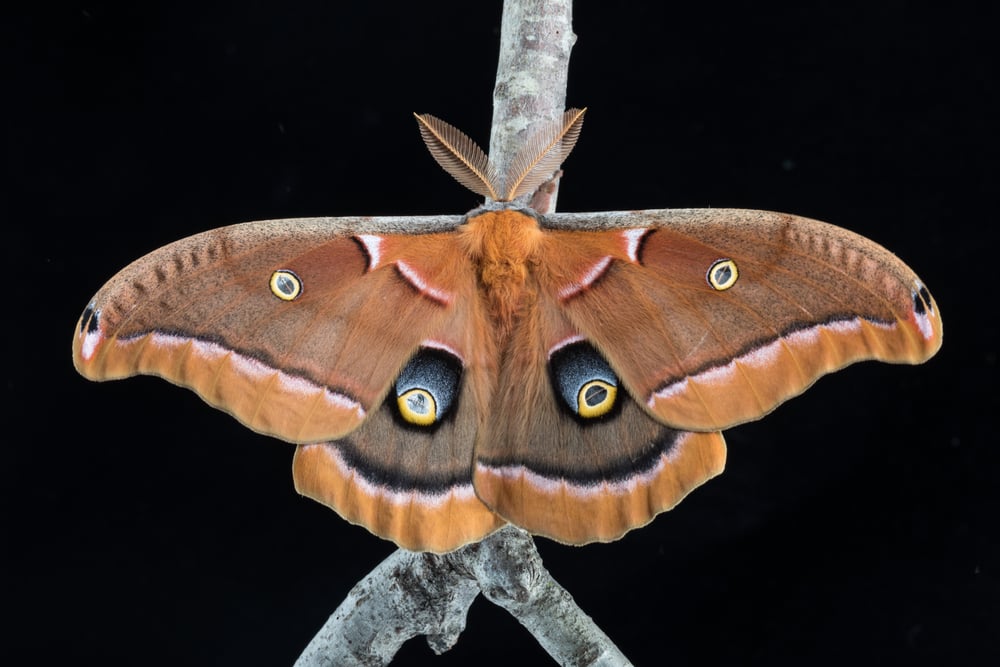
Identifying Characteristics and Facts
- Wingspan of up to 6 inches.
- The hindwings have eye spots for confusing predators.
- Females lay eggs on host plants.
- Tan to reddish-brown.
- Grows to up to 3 inches in body length.
- Strong flyers and can do up to 10 miles in a night.
The Polyphemus Moth has a wingspan that can reach up to 6 inches. It holds the distinction of being one of the largest moths in the region.
Its name draws inspiration from the creature, Polyphemus, known for its single eye. As if that is not enough, this moth displays eye spots on each of its hindwings which serve as a clever defense mechanism to confuse potential predators.
When warm summer nights arrive, these nocturnal creatures are drawn to lights. The female moths release pheromones to attract their mates. They then lay eggs on host plants such as oak and maple trees.
#10. Cecropia Moth (Hyalophora cecropia)
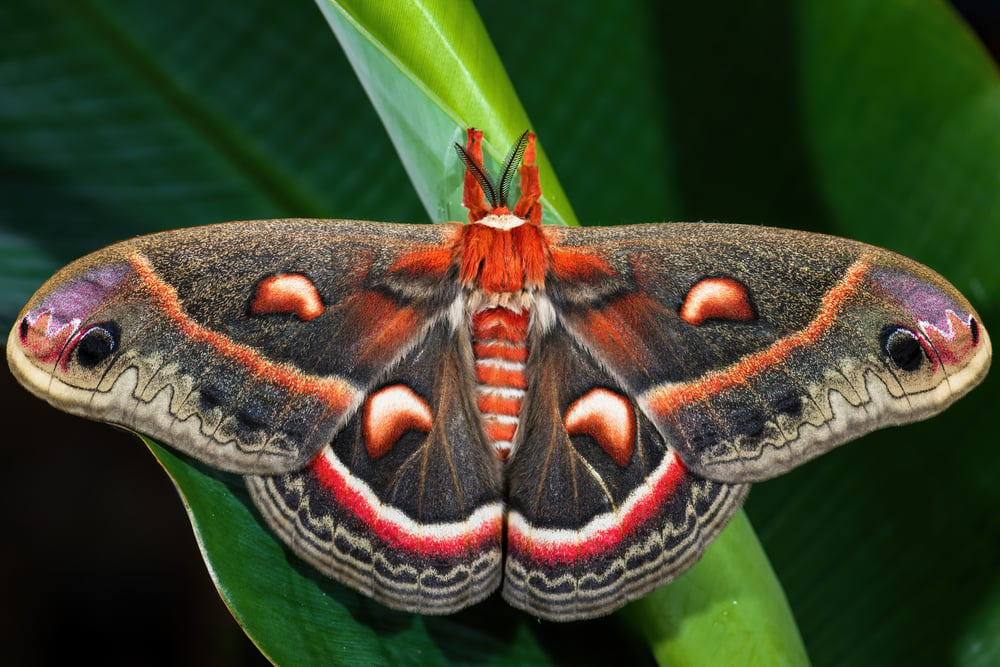
Identifying Characteristics and Facts
- Have a wingspan of 5 – 7 inches.
- Hairy body with some reddish color on the anterior.
- Alternating bands of white and red on the abdomen.
- Undergo a complete life cycle or metamorphosis.
- Nocturnal and attracted to lights.
- Food source for most birds.
- Helps in promoting plant pollination.
Cecropia Moth is the most common in Pennsylvania. It is also well-distributed in many parts of the world. Of course, these moths play a significant role in the ecosystem. They are food to most of the bird species and also help a lot in pollination.
These moths are fairly large and you will find them mostly in maple trees. You will also find them in birch and cherry trees. Of course, these moths also live in various habitats and they are helpful in the ecosystem.
When you see them, it is important to understand that they are not poisonous or harmful to humans. However, the caterpillars can be irritating.
As a reminder, the below factors are common for the most common moths:
- Beneficial to the environment. These are some of the best pollinators for flowers, plants, gardens, and so much more.
- Have similar characteristics to each other
- One of the easiest ways to identify them is based on the wing colors and spots
- Most butterflies will migrate and some butterflies will have more than one brooding in a season.